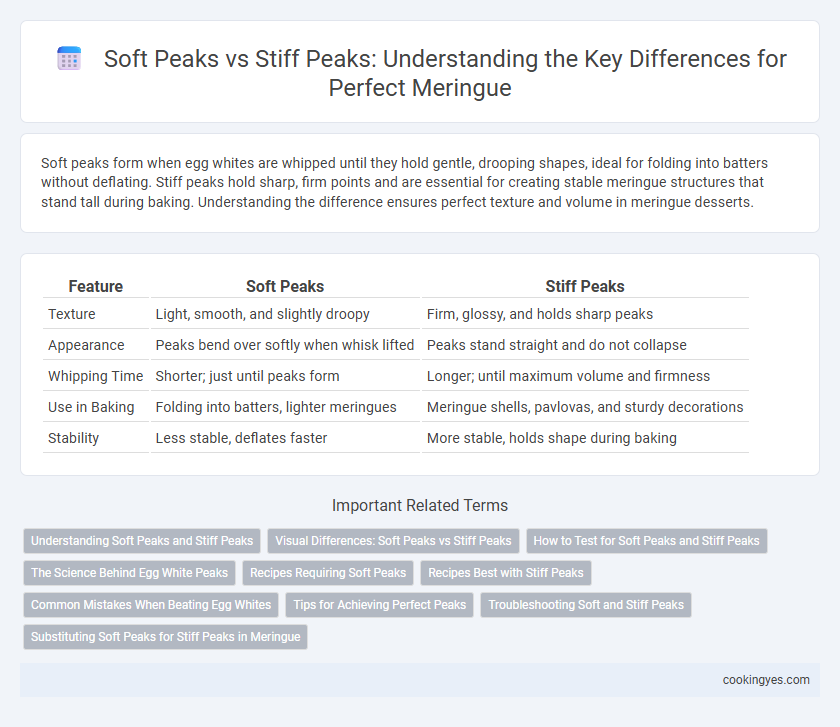Soft peaks form when egg whites are whipped until they hold gentle, drooping shapes, ideal for folding into batters without deflating. Stiff peaks hold sharp, firm points and are essential for creating stable meringue structures that stand tall during baking. Understanding the difference ensures perfect texture and volume in meringue desserts.
Table of Comparison
| Feature | Soft Peaks | Stiff Peaks |
|---|---|---|
| Texture | Light, smooth, and slightly droopy | Firm, glossy, and holds sharp peaks |
| Appearance | Peaks bend over softly when whisk lifted | Peaks stand straight and do not collapse |
| Whipping Time | Shorter; just until peaks form | Longer; until maximum volume and firmness |
| Use in Baking | Folding into batters, lighter meringues | Meringue shells, pavlovas, and sturdy decorations |
| Stability | Less stable, deflates faster | More stable, holds shape during baking |
Understanding Soft Peaks and Stiff Peaks
Soft peaks form when egg whites are whipped until they hold shape but tips gently fold over when the whisk is lifted, ideal for lighter meringues and mousses. Stiff peaks occur when egg whites are beaten until they stand straight and firm without bending, essential for stable meringues and souffles that require structure. Differentiating between these stages ensures the correct texture and stability in recipes dependent on egg white aeration.
Visual Differences: Soft Peaks vs Stiff Peaks
Soft peaks in meringue appear glossy with smooth, flowing curves that gently fold over when the whisk is lifted, indicating moderate egg white aeration. Stiff peaks hold their shape firmly, standing upright with sharp, defined tips and a matte finish, reflecting maximum air incorporation and stability. Recognizing these visual differences is crucial for achieving the desired texture and structural integrity in meringue-based desserts.
How to Test for Soft Peaks and Stiff Peaks
To test for soft peaks in meringue, lift the whisk from the mixture and observe the egg whites forming smooth, drooping peaks that gently fold over at the tips. For stiff peaks, the egg whites should stand upright with sharp, pointed tips that hold their shape firmly without collapsing. Using a clean, dry whisk and cold egg whites enhances accuracy in achieving the desired peak consistency essential for different meringue textures.
The Science Behind Egg White Peaks
Egg white proteins unfold and form a stable foam when air is whipped into them, trapping air bubbles crucial for meringue structure. Soft peaks occur when egg whites form gentle, flexible peaks that bend slightly, ideal for folding into batters without deflating. Stiff peaks develop as the foam becomes more rigid and glossy, providing maximum stability and volume essential for meringue's airy texture and hold.
Recipes Requiring Soft Peaks
Soft peaks are ideal for recipes like mousses, souffles, and certain meringue toppings where a light, airy texture is essential. When egg whites reach soft peaks, they create a gentle foam that folds smoothly into other ingredients without deflating. Achieving soft peaks ensures stability while maintaining flexibility, making them perfect for delicate culinary applications.
Recipes Best with Stiff Peaks
Stiff peaks form when egg whites are whipped until they stand straight without bending, ideal for recipes like Swiss meringue, pavlova, and macarons needing firm, stable structure. Soft peaks are less rigid and better suited for delicate dishes such as mousse or angel food cake, where a lighter texture is desired. Recipes demanding a glossy, stable meringue for baking or piping consistently require stiff peaks for optimal results and maximum volume.
Common Mistakes When Beating Egg Whites
Common mistakes when beating egg whites for meringue include under-whipping, which results in soft peaks that collapse easily, and over-whipping, leading to stiff peaks that become dry and grainy. Using bowls or utensils with traces of grease or yolk prevents proper foam formation, causing egg whites to fail in reaching desired peak stages. Temperature plays a critical role; egg whites at room temperature whip more efficiently, while cold whites may take longer and unevenly develop peaks.
Tips for Achieving Perfect Peaks
To achieve perfect soft peaks, whip egg whites until they form gentle, flexible peaks that curl over when the beaters are lifted, ensuring they remain glossy and not dry. For stiff peaks, continue whipping until the whites stand straight up without drooping, but avoid overbeating to prevent grainy texture or separation. Use a clean, grease-free bowl and room-temperature eggs to maximize volume and stability in your meringue.
Troubleshooting Soft and Stiff Peaks
Soft peaks in meringue appear glossy and gently fold over when the whisk is lifted, indicating the egg whites are adequately aerated but not overbeaten, preventing dryness and collapse. Stiff peaks stand straight up without bending, signifying maximum volume and stability, but overbeating at this stage risks grainy texture and separation of egg whites. Troubleshooting involves stopping whisking as soon as peaks reach the desired firmness to avoid under or overwhipping, ensuring the addition of sugar is gradual for stability, and maintaining clean, grease-free bowls to promote proper foam formation.
Substituting Soft Peaks for Stiff Peaks in Meringue
Soft peaks in meringue appear when egg whites form gentle, drooping peaks that slightly bend over, containing more moisture and less air incorporation compared to stiff peaks, which stand upright and are more stable due to greater protein network formation. Substituting soft peaks for stiff peaks in meringue results in a softer, less structured texture with reduced volume and stability, often causing the final product to collapse or weep during baking. For recipes requiring stiff peaks, gently folding in additional sugar or extending whipping time can help achieve the necessary firmness to maintain meringue structure.
Soft peaks vs Stiff peaks for meringue Infographic

 cookingyes.com
cookingyes.com